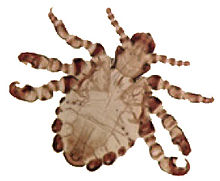- Pthirus gorillae
-
Pthirus gorillae 
A magnified image of Pthirus gorillae Scientific classification Kingdom: Animalia Phylum: Arthropoda Class: Insecta Order: Phthiraptera Family: Pthiridae Genus: Pthirus Species: P. gorillae Binomial name Pthirus gorillae
Ewing, 1927Pthirus gorillae or gorilla louse is a species of parasitic sucking louse that afflicts gorillas.[1] It is found in the African continent specifically in Rwanda and Democratic Republic of the Congo.[2] Pthirus gorillae and Pthirus pubis or the crab louse are the only known species that belong to the genus Pthirus, often incorrectly spelled as Phthirus and Phthirius.[3] It is suggested that it is transmitted amongst its hosts by social grooming, shared breeding and sexual contact.[4]
All species of sucking lice feed on blood.[5] They live in close association with their hosts and complete their entire life cycle on the host.[1] Pthirus gorillae infests the same parts of the bodies of gorillas as Pthirus pubis does in humans,[6] but since the gorilla is so much more hirsute, the lice tend to range over the whole body.[7] The two also resemble each other with the exception that Pthirus gorillae has large eyes that are placed on large lateral protuberances. A short and broad sucking louse, it is about 2.20 mm long with sprawling legs and not more than 20 small abdominal setae.[4] While morphologically these species are indistinguishable, they are clearly different in terms of behaviour, microhabitat preference and vector status.[5]
It was first identified from specimens of mountain gorillas in 1927 by Henry Ellsworth Ewing during a game hunting trip in what is now the Democratic Republic of the Congo.[4] Molecular phylogenetics suggests that Pthirus gorillae jumped from gorillas to early humans 3.3 million years ago and diverged into the present day pubic louse.[1][8] Some researchers have theorized that humans acquired the parasite not through interspecies sex but while scavenging on gorilla corpses or sleeping in the abandoned sleeping nests of gorillas.[9][10] A more recent theory based on genetic evidence is that lice evolved alongside humans, and that the crab louse diverged from Pthirus gorillae some 13 million years ago, as humans diverged from apes.[11]
References
- ^ a b c David L. Reed, Jessica E. Light, Julie M. Allen & Jeremy J. Kirchman (2007). "Pair of lice lost or parasites regained: the evolutionary history of anthropoid primate lice". BMC Biology 5: 7. doi:10.1186/1741-7007-5-7. PMC 1828715. PMID 17343749. http://www.biomedcentral.com/1741-7007/5/7.
- ^ "Pthirus gorillae Ewing, 1927". Integrated Taxonomic Information System. http://www.itis.gov/servlet/SingleRpt/SingleRpt?search_topic=TSN&search_value=624833. Retrieved 30 September 2010.
- ^ Robert Frederick Harwood & Maurice Theodore James (1979). Entomology in human and animal health. Macmillan. p. 130. ISBN 9780023516009.
- ^ a b c Jessica M. Rothman, Dwight D. Bowman, Gladys Kalema-Zikusoka & John Bosco Nkurunungi (2006). "The Parasites of the Gorillas in Bwindi Impenetrable National Park Uganda". In Nicholas E. Newton-Fisher, Hugh Notman & James Durward Paterson. Primates of Uganda. Springer Science+Business Media. pp. 171–192. ISBN 9780387323428. http://books.google.com/books?id=4P9u4Lrk_GkC&pg=PA188.
- ^ a b Jonathan F. Day, John D. Edman, Sidney E. Kunz & Stephen K. Wikel (2004). "Direct Injury: Phobias, Psychoses, Annoyance, Allergies, Toxins, Venoms and Myiasis". In Bruce F. Eldridge & John D. Edman. Medical Entomology: A Textbook on Public Health and Veterinary Problems. Kluwer Academic Publishers. pp. 99–149. ISBN 9781402017940. http://books.google.com/books?id=C7OxOqTKYS8C&pg=PA109.
- ^ Robert S. Anderson, Richard Beatty & Stuart Church (2003). "Sucking louse". Volume 5. Harvester ant–Leaf-cutting ant. Insects and Spiders of the World. Marshall Cavendish. pp. 520–523. ISBN 0-7614-7339-5. http://books.google.com/books?id=V1h8nqFXjN8C&pg=PA523.
- ^ Sydney Harold Skaife & Anthony Bannister (1979). African Insect Life. C. Struik. p. 83. ISBN 9780869770870.
- ^ May R. Berenbaum (2009). "The Domesticated Crab Louse". The Earwig's Tail: A Modern Bestiary of Multi-legged Legends. Harvard University Press. pp. 24–28. ISBN 9780674035409. http://books.google.com/books?id=FOlpPl_15csC&pg=PA27.
- ^ Roxanne Khamsi (7 March 2007). "Pubic lice leapt from gorillas to early humans". New Scientist. http://www.newscientist.com/article/dn11330-pubic-lice-leapt-from-gorillas-to-early-humans.html.
- ^ Jesse Bering (1 March 2010). "A bushel of facts about the uniqueness of human pubic hair". Bering in Mind. Scientific American. http://www.scientificamerican.com/blog/post.cfm?id=a-bushel-of-facts-about-the-uniquen-2010-03-01. Retrieved 30 September 2010.
- ^ NICHOLAS WADE (6 April 20011). "As Mammals Supplanted Dinosaurs, Lice Kept Pace". New York Times. http://www.nytimes.com/2011/04/12/science/12louse.html.
External links
- Apes, lice and prehistory by Robin A Weiss
- Genetic Analysis of Lice Supports Direct Contact between Modern and Archaic Humans by David L. Reed et al.
Categories:- Lice
- Insects of Africa
- Animals described in 1927
Wikimedia Foundation. 2010.
